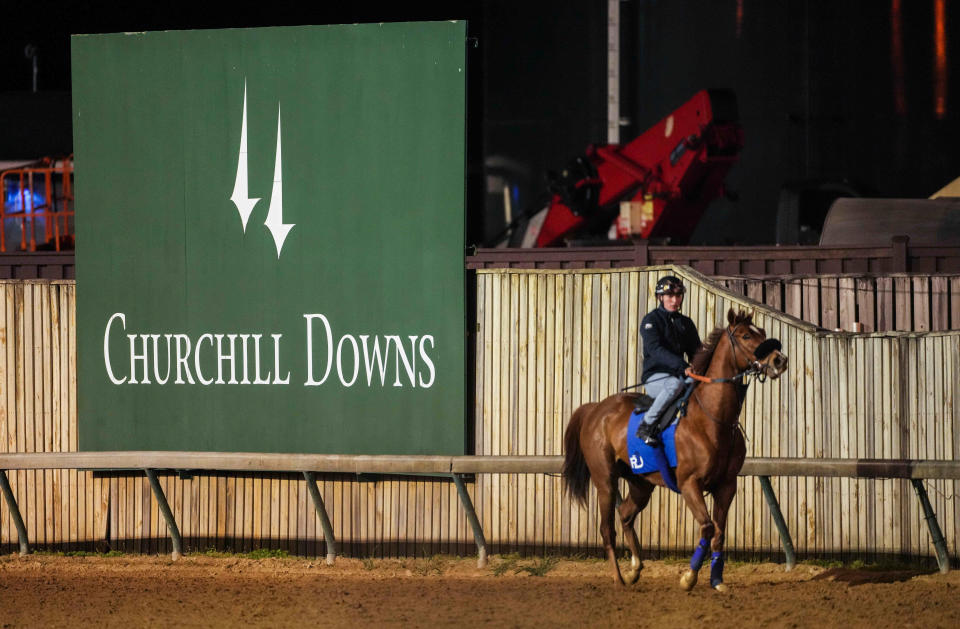Inside Kentucky Derby pace that will decide winner: First half mile is key
LOUISVILLE, Ky. — The Kentucky Derby is a long race, but for most of the field, the outcome will be determined in the first half mile.
If you are backing a horse that comes from off the pace, you want the leaders to expend a lot of energy setting fast fractions. For horses that like to run toward the front, a slower pace will give them a better chance to hang on. That’s true in any horse race, but it’s particularly important in the Derby, where a 20-horse field and a bunch of nervous jockeys can create unique pace scenarios.
Last year, for instance, longshot Summer Is Tomorrow ran the fastest opening quarter-mile in Derby history (21.78 seconds) and the fifth-fastest half (45.36 seconds) before fading to last place. The insane pace also cooked the group of six or seven horses that tried to run in a pack with Summer is Tomorrow, and the race turned into a cavalry charge coming into the stretch as the horses in front began to stop. That opened the door for longshot Rich Strike, who had lingered near the back of the pack early, to pass tired horses and get up for the win.
SECRETARIAT'S TRIPLE CROWN TURNS 50 Why there's no GOAT argument in horse racing
A WINNER? Forte gives billionaire owner Mike Repole best Kentucky Derby chance yet

Conversely, the 2020 Derby saw Authentic get out to an unchallenged lead while running a full second slower for the first half mile (46.41).
The lack of pressure allowed jockey John Velazquez to back off the throttle just a little bit and save his horse until the battle was engaged with Tiz the Law in the stretch.
The possible pace scenarios for Saturday’s 149th Kentucky Derby have been a huge topic on the backstretch at Churchill Downs this week. Here’s what you need to know:
Lack of obvious speed
This is the rare Derby where most of the top contenders want to come from off the pace. Forte, the favorite, has won his last three races with sustained, sweeping moves around the far turn. Angel of Empire was seventh of 10 horses after the first half mile of his Arkansas Derby win. Tapit Trice was eight lengths off the lead in the early stages of his wins in the Tampa Bay Derby and Blue Grass Stakes.
For all three, there’s at least some concern about having a fast enough pace to run at. But Bill Mott, who won the 2019 Derby with Country House and trains Rocket Can in this one, said the perception of a slow pace could influence the riders to be more aggressive.
“Usually, there’s rarely a total lack of pace,” Mott said. “Everybody sees that and they’ll try to change tactics. Somebody will go.”
Who’s likely to be on the lead?
Kingsbarns, who was purchased for $800,000 as a 2-year-old last year, is 3-for-3 in his career and won the Louisiana Derby wire-to-wire. He is most likely to be leading the race after the first quarter mile with pressure from Verifying, Reincarnate and the Japanese entry, Derma Sotogake.
Verifying has settled in just behind the leaders in his last few races but drew the No. 2 post position, which ensures that jockey Tayler Gaffalione will need to hustle him out of the gate and avoid the crush of horses to his outside trying to get rail position. Reincarnate showed a lot of speed in the 1-mile Sham Stakes in January, running a very fast 45 2/5 seconds for six furlongs before finishing the race in 1:35 4/5. And Derma Sotogake went wire-to-wire in the UAE Derby, a performance that caught the interest of some sharp handicappers even though foreign imports have a terrible Derby record.
If any of those horses are running up front and the half-mile fraction is around 47 seconds, they’ll have a good chance to carry their speed the whole way around.
How do jockeys judge pace anyway?
If you’re watching a race, it’s easy to tell whether a pace is fast or slow by looking at the timer. Generally speaking, a quarter mile in the 21-22 second range is quite fast while 23-24 is pretty slow — and that difference of just a couple seconds will have a cascading effect on how the rest of the race is run.
But for a jockey on horseback without the advantage of looking at a clock, how can you judge the pace? Jerry Bailey, a Hall of Fame rider who won the Kentucky Derby twice and now works for NBC Sports, said it all comes down to experience.
“Good riders know pace by reputation — it’s like driving,” he said. “If you go 65 miles an hour enough, you know what it feels like. You know if it’s 85, you’re passing other horses or landmarks really fast and that's how you know yore going fast or slow. The other element is you know your horse. If your horse is a closer and he’s naturally (up front) and doing it easily, you know they’re going slow. If he’s supposed to be seventh or eighth and he’s 15th and doing things the way he normally does, you know it’s really fast up front. It’s repetition of being in races and knowing your horse.”
This article originally appeared on USA TODAY: Kentucky Derby horses pace will determine winner. What to expect.

